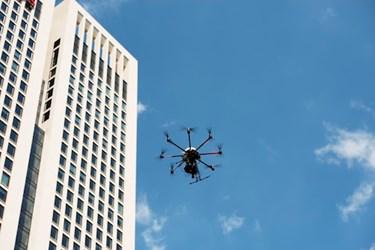UPS Octocopter Drone Delivery Test Meets With Modest Success

By Christine Kern, contributing writer

Company acknowledges modifications are still necessary to the program.
UPS announced it has worked with truck-launched drone-maker Workhorse Group for a successful test of an octocopter drone to make a delivery to a blueberry farm in Lithia, FL. The drone was launched from the top of a UPS package car, made the delivery, and returned to the vehicle while the driver continued on his route some 2,000 feet to make a separate delivery, according to Bloomberg.
“This test is different than anything we’ve done with drones so far. It has implications for future deliveries, especially in rural locations where our package cars often have to travel miles to make a single delivery,” says UPS senior vice president of global engineering and sustainability Mark Wallace. “Imaging a triangular delivery route where the stops are miles apart by road. Sending a drone from a package car to make just one of those deliveries can reduce costly miles driven. This is a big step toward bolstering efficiency in our network and reducing our emissions at the same time.”
Workhorse, the same company that provides electrified trucks to UPS, developed the drone system using the HorseFly octocopter. The drone deploys from the roof of the truck and can carry a package weighing up to 10 pounds. Current FAA rules require a visual line of sight between the drone and its operator, but it runs on an autonomous route unless the driver needs to take over for some reason. The HorseFly communicates with the truck via 4G with RF as a backup. While this first delivery was pre-programmed, future routes could be determined by UPS’s On-Road Integrated Optimization and Navigation (ORION) routing software.
General estimates are reducing each driver’s mileage by just one mile per day could save UPS $50 million in costs a year and, with more than 100,000 road vehicles in operation nationwide, those savings quickly add up.
“The toughest thing, technically, is having the HorseFly drone re-mate with the electric truck,” Workhorse founder and CEO Stephen Burns told Tech Crunch. “There’s a small portal. We basically have to have a robotics system up on the top that grabs it, picks it up, and puts it in the hole.”
The test demonstrated, however, the technology is not quite ready to be fully deployed. During the pilot run, a drone stumbled upon liftoff and was nearly crushed as the truck’s sliding roof panel closed, as AutoBlog reported. And Wallace told Bloomberg, “Drones won’t replace our uniformed service providers. That’s key, but in this case, it really is there to assist.”
FAA regulations also remain an obstacle for the widespread use of drones for delivery, and the agency is still refining the rules that will govern widespread commercial use of drones. Drone malfunctions remain a serious concern for U.S. citizens, who generally want drone deliveries but are worried about injurious mishaps according to USPS survey.
